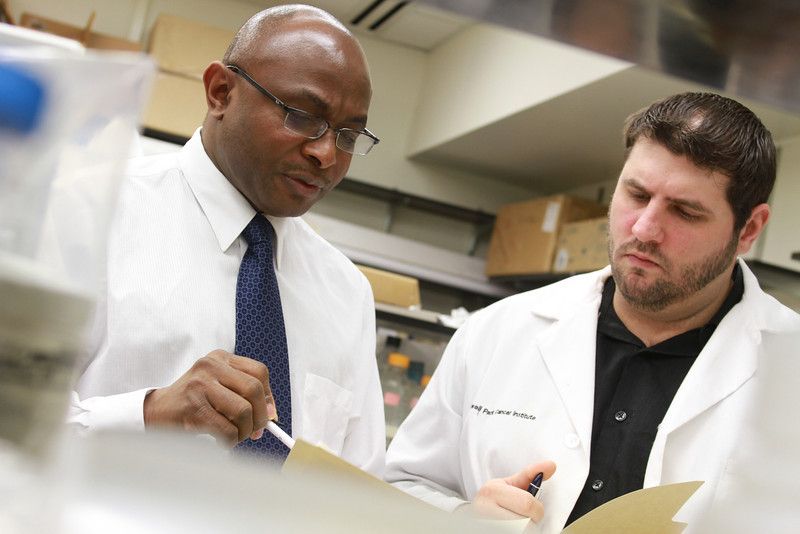In 2015 alone, more than 21,000 women will receive a diagnosis of ovarian cancer and approximately 14,000 women will die of the disease. Often diagnosed at advanced stages, ovarian cancer is aggressive and particularly tough to treat. Women may initially respond positively to chemotherapy, but the benefits seldom last. About 80-85 percent of people with ovarian cancer will relapse or develop chemo-resistance, according to the American Cancer Society.
The immune system is a powerful tool in the fight against cancer. With the right therapies, our body’s built-in weapon can target and kill tumors. But not all cancers are created equal. They all express subtle variations of surface molecules – called cancer antigens or proteins – making them elusive and unpredictable.
Immunotherapy clinical trials have yielded standout results, including partial and complete remission in patients with some types of advanced cancers. Unfortunately, cancer cells evolve, get smarter, and learn to evade or suppress the immune system over time. So, once beaten back by the immune system, how long do these advanced cancers remain at bay?
Kunle Odunsi, MD, PhD, former Chair of the Department of Gynecologic Oncology, executive director of the Division of Translational Immuno-Oncology, and Deputy Director at Roswell Park, is determined to find out.
He and his team spent the last decade studying how to generate better, longer-lasting immune therapies to treat advanced ovarian cancer – a difficult disease with a grim prognosis. To support these efforts, the New York State Stem Cell Science Program (NYSTEM) awarded the team an $11.8 million grant for continued research. These funds demonstrate the urgency to find innovative ways to eradicate this deadly disease.
In this blog post, Odunsi, who has been a member of the American Association for Cancer Research since 2002 and currently serves on the editorial board for the AACR’s journal Cancer Immunology Research, takes us inside the lab and explains some research that has the potential to improve the lives of ovarian cancer patients.
Can you tell us about your hypothesis of utilizing patients’ stem cells to target ovarian cancers using an immunotherapy approach?
We hope to improve the odds for ovarian cancer patients by using an immunotherapy approach known as adoptive T-cell therapy. It is a novel treatment that, if it works, has the potential to forever change the way we approach ovarian cancer management.
T-cells, a type of white blood cell, attack foreign invaders in the body - this includes tumors, bacteria and viruses. But cancer cells are resilient and sometimes overpower the body’s army of fighter T-cells. To combat this, we tapped into the long-term, regenerative power of stem cells. We found that with some manipulation, we can turn these stems cells into billions of cancer-fighting immune cells.
The goal is that once the re-engineered cells are infused back into the body, they lodge in bone marrow and become a potentially life-long source of cancer control. It becomes a very promising approach, not only to control existing disease but also to potentially prevent future relapse of the disease.
What will be the clinical process for this stem-cell therapy?
Stem cells are present in the blood and are extracted from the patient through a standard blood draw. Stem cells are separated from the sample and sent to the lab to be re-engineered to recognize tumor cells and attack them. To do this, we arm the stem cells with a molecule or receptor normally found on the membrane of cancer-fighting T-cells. This receptor targets an antigen (or protein) called NY-ESO-1 that is overexpressed by tumors but not most normal tissue. Once the re-engineered cells are infused back into the blood, they target this antigen and commence tumor destruction without causing damage to healthy tissue. The regenerative power of stem cells is the key to long-term tumor control.
Where does this study currently stand?
The preclinical data shows that human hematopoietic stem cells (hHSC) isolated from adult peripheral blood can be re-engineered to differentiate into/become mature T cells with the capacity to recognize and kill tumor cells. In a preclinical tests, hHSC engineered to express a novel tumor-recognizing NY-ESO-1 specific T cell receptor (TCR) were detectable in circulation and within lymphoid organs. We are currently testing the anti-tumor efficacy in the same model of peritoneal ovarian cancer. The dose and timing of transduced hHSC to administer is under evaluation. The NYSTEM investment will allow us to conduct additional studies that will enable the FDA to approve the use of this therapy in patients.
How will this therapy impact the lives of ovarian cancer patients?
We expect the treatment to be effective against any type of ovarian cancer that expresses the NY-ESO-1 antigen target. So there is huge potential to impact a broad range of patients with this disease. And because NY-ESO-1 is so widely expressed by various malignant tumors, the approach may have an application in the treatment of other cancers.
How will this therapy evolve over the next few years?
The NYSTEM grant will support the first clinical trial to utilize adult HSCs in cancer immunotherapy. Preclinical IND-enabling studies are underway. When these are completed along with FDA/IRB approval, this trial will be activated at Roswell Park. The data thus far demonstrate that HSCs can be reprogrammed to mature and grow into functional antitumor immune cells that stay in the body for a long period of time resulting in improved tumor control. We hope that this stem cell approach will initially treat patients who have failed standard therapies, such as chemotherapy. In the future, we anticipate that it may also be used after remission to minimize the risk of relapse.
This blog post originally appeared on Cancer Research Catalyst, the official blog of the American Association for Cancer Research.
